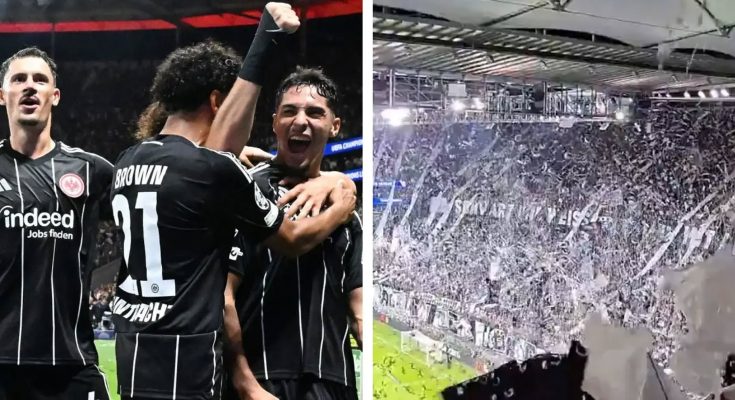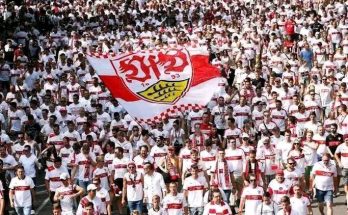The night in Frankfurt was one that will be remembered for years to come, a magical evening that transcended the borders of sport and became a symbol of pride, passion, and unity. Eintracht Frankfurt had done it again—they were back in the Champions League, back on the grand European stage where their spirit and their fans always seem to shine the brightest. But this was no ordinary return. As the team lined up against Galatasaray, one of Europe’s most storied clubs, the stadium erupted in a spectacle that seemed less like a football match and more like a living, breathing piece of art.
The Eintracht faithful are no strangers to incredible displays, having built a reputation across Europe as one of the most passionate and creative fan bases. But this choreography of flags, stretching across the Waldstadion with breathtaking precision, was something different. It was a declaration. Thousands of flags in black, white, and red rippled in perfect unison, creating waves of color that symbolized both the club’s history and its unwavering will to conquer new challenges. The fans had planned it meticulously, spending weeks organizing every detail, making sure each supporter knew their role, and as the moment arrived, the choreography unfolded flawlessly.
The sheer emotion of the display was overwhelming. From the pitch, the players stood in awe, many of them visibly moved as they looked up at the stands. Veterans of European nights admitted later that they had rarely seen such unity and power from supporters. For the younger players, it was a reminder of just how much the shirt meant to those who wore it in the stands. The choreography was more than just an impressive visual—it was a statement of belonging, of identity, and of belief. It was as though the fans were saying: “We are here, and we will not be ignored.”
Against Galatasaray, themselves renowned for a fan culture steeped in noise and intimidation, Frankfurt’s fans wanted to send a message not only to their opponents but also to Europe as a whole. This was their return, and they would make sure the continent noticed. As the Champions League anthem rang out, the combination of the music, the flags, and the roar of tens of thousands created a scene of almost cinematic power. Every supporter felt like part of something bigger, part of a family that had weathered ups and downs but always returned stronger.
The choreography was not just about beauty; it was steeped in symbolism. The flowing lines of flags across the terraces mirrored the river Main, which runs through the heart of Frankfurt and has always been tied to the city’s identity. The club crest shone proudly at the center of the display, a reminder of the eagle that soars above adversity. Each flag carried the soul of the supporter holding it, a small contribution to a greater masterpiece. The energy seemed to pour down from the stands and onto the pitch, igniting the players with a sense of duty and determination.
For many fans, this return to the Champions League marked the culmination of years of loyalty through both glory and hardship. Eintracht Frankfurt has never been a club to do things the easy way. They have experienced heartbreaks, relegations, and doubts, but time and time again they have fought back. Nights like this remind everyone why the bond between the club and its supporters is so unbreakable. The Champions League anthem was more than just a song—it was a reward for every supporter who had stood by the team through the darkest times.
Galatasaray’s players and traveling fans could not help but admire the spectacle before them. Known for their own fiery support back in Istanbul, they recognized a kindred spirit in Frankfurt’s faithful. This clash of cultures, two fan bases that live and breathe their clubs, elevated the occasion beyond football. The visiting supporters responded with their own chants, but for that moment, the spotlight belonged firmly to the home crowd. The flags continued to wave, a sea of movement that never seemed to tire, and the volume of the chants created a wall of sound that pushed Eintracht forward.
The match itself became secondary in the early minutes, as even neutral viewers found themselves captivated by the atmosphere. Social media exploded with images and videos of the choreography, fans from across Europe sharing their admiration. Commentators called it one of the most beautiful displays of support in the competition’s recent history, noting how seamlessly the fans combined artistic expression with raw passion. This was Frankfurt’s trademark, a blend of creativity and intensity that few others could replicate.
For the players, the choreography and the atmosphere were a promise. It was the fans telling them that they would never walk alone into battle. Every duel, every sprint, every shot would be backed by tens of thousands of voices willing them to succeed. That energy translated into the game, as Eintracht fought fiercely against their Turkish opponents. Every tackle was cheered like a goal, every clearance met with thunderous applause, and every attack carried the weight of an entire city’s hope.
The return to the Champions League also held deeper meaning for the club itself. It was a signal of progress, of the journey from being outsiders to reclaiming their place among Europe’s elite. Frankfurt has always had a unique position in German football, a club with massive support and tradition but often forced to fight harder than the giants like Bayern Munich or Borussia Dortmund. Nights like this proved that their strength lay in their unity, in the bond between team and supporters that no amount of money could replicate.
As the game went on, the choreography gave way to endless chants and songs, but its memory lingered. Long after the flags were folded and the stadium lights dimmed, supporters knew they had created something unforgettable. Many fans spoke of goosebumps, of tears in their eyes as they waved their flags and saw the sea of colors around them. It was not just about football—it was about being part of something eternal. For children in the stands, it was their first taste of true European magic; for older fans, it was a reminder of why they had never given up on the club they loved.
Even after the final whistle, as players walked around the pitch to applaud their supporters, the emotion hung heavy in the air. Some players draped flags over their shoulders, others clapped until their hands hurt, but all of them knew they were witnessing history. Frankfurt’s fans had set a standard not just for themselves but for the entire competition. This was the Champions League in its purest form: passion, pride, and community.
The city itself buzzed with energy in the days that followed. Cafés, workplaces, and schools echoed with stories of the choreography. People shared photos, videos, and personal experiences, each one carrying their own angle on the unforgettable night. It became clear that this was more than just a football event—it was a cultural moment for Frankfurt. The club had united the city, reminding everyone of the strength that comes from standing together.
What made the choreography so special was not just the scale but the authenticity. It wasn’t corporate, it wasn’t orchestrated by outside forces—it was built by the fans, for the fans, out of love for their club. That authenticity gave it soul. It wasn’t just a visual display but a heartbeat, pulsing through the stadium and out into the world. Every supporter who waved their flag knew they were part of history, part of a night that would live on in memory and legend.
The Champions League is full of giants with bigger budgets and star-studded squads, but Eintracht Frankfurt showed that sometimes, the greatest weapon a club can have is its fans. Against Galatasaray, before a ball had even been kicked, Frankfurt had already won something priceless: the respect and admiration of Europe. The flags may have been simple pieces of cloth, but together they became a tapestry of identity, woven tightly by the love of a city for its team.
In the end, the choreography was more than just a celebration of returning to the Champions League—it was a celebration of what football means to people. It was a reminder that at the heart of this global sport are communities, memories, and emotions that cannot be measured in trophies or revenue. For Eintracht Frankfurt and their fans, it was a night that said: “We are back, and we belong.”
And as the lights of the stadium faded and supporters poured into the streets to continue their songs, one truth was clear: the flags had not just waved for a match; they had waved for history, for passion, and for the unshakable spirit of Eintracht Frankfurt. The Champions League is richer for having them back, and their fans had made sure the whole world knew it.



